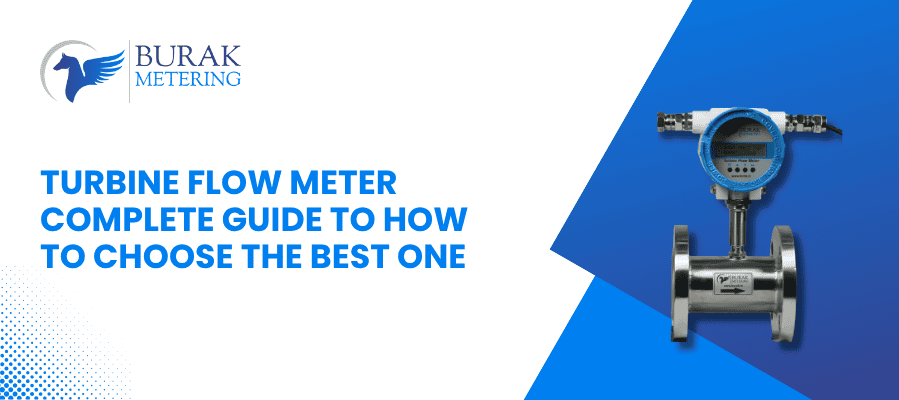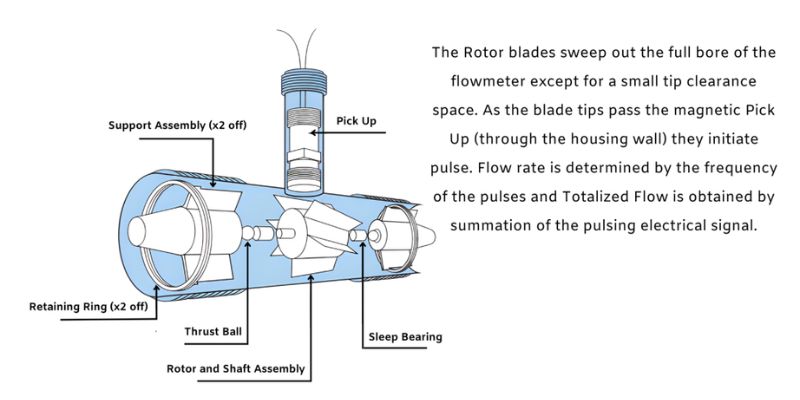 Phone
Phone

A Turbine flowmeter is a widely used device for flow measurement of a liquid and gaseous fluid in industries like oil & gas, water treatment, pharmaceuticals, and manufacturing.
It works on the Mechanical rotation principle. A rotating turbine is placed into the flow path of the turbine flowmeter, whose speed is proportional to the fluid velocity.
In this blog, we will detail the working principle, key components, advantages, limitations, and factors to consider when selecting a Turbine flowmeter.
These aspects will help you in choosing the right flowmeter and ensure accurate measurement.

A Turbine flowmeter operates on a simple yet highly effective principle I.e. Mechanical rotation
It measures the flow rate of liquids or gases by detecting the rotational speed of the turbine rotor, which is placed inside the flow stream of the flowmeter.
The faster the fluid or gas moves through the turbine rotor, the faster it spins. This rotational speed is then used to determine the flow rate.
Here’s a step-by-step breakdown of how a turbine flow meter works:
A turbine flow meter includes several critical components:
In digital models, the system often includes communication protocols like Modbus or HART for integration with industrial control systems.
A digital turbine flow meter also provides enhanced data logging, remote monitoring, and real-time alerts.
Accuracy depends on several factors: sensor sensitivity, fluid type, temperature, and pipeline conditions. Clean, low-viscosity fluids yield the best results.
Straight pipe runs, typically 10 diameters upstream and 5 downstream, help reduce turbulence, which can impact readings.
Proper calibration using the manufacturer’s K-Factor ensures reliable measurements.
For gases, using a natural gas turbine flow meter or turbine gas meter built for the specific application is essential.
Turbine flow meters are not ideal for slurries, steam, or fluids with high particulate matter, as these can damage the rotor or skew results.
They should also be installed away from valves or elbows to prevent distorted flow profiles.
Discover high-precision inline turbine flow meters for your industry.
Contact Burak Metering for turbine flow measurement solutions.
Turbine flow meters are widely used across multiple industries due to their high accuracy, fast response time, and compatibility with a wide range of fluids and gases. These meters offer dependable volumetric flow measurement, making them ideal for both liquids and gases under steady, clean flow conditions.
Turbine flow meters play a critical role in the oil and gas industry, especially in applications like:
Their reliability and accuracy make them well-suited for custody transfer, regulatory compliance, and production monitoring.
Turbine flow meters are widely adopted in chemical plants for:
Turbine meters support safe and efficient chemical operations, especially in batch and continuous processing environments.
In power generation plants, turbine flow meters are used to:
Accurate measurement ensures efficient energy usage and helps maintain compliance with environmental regulations.
Compressed air is a vital utility in many industries. Turbine flow meters help monitor:
Their ability to handle high flow rates makes them ideal for industrial compressed air applications.
In **water treatment plants**, turbine flow meters are used to:
Turbine meters help maintain operational stability and regulatory compliance in municipal and industrial water treatment.
In the food and beverage sector, turbine flow meters provide precise flow control for:
Hygienic turbine meters with sanitary designs are commonly used in this industry to meet food safety standards.
Precision is essential in the pharmaceutical industry, and turbine meters are used to:
Stainless steel and sanitary-grade turbine meters are often selected to meet the strict hygiene and validation requirements in pharma operations.
Turbine gas flow meters are applied in biogas plants, landfills, and flare gas systems for:
Turbine meters provide precise readings, making them ideal for custody transfer, dosing, and process control.
They respond quickly to changes in flow rate, supporting real-time monitoring in dynamic systems.
Turbine flow meters handle a broad spectrum of flow rates without compromising measurement accuracy.
These meters are engineered for minimal flow resistance, helping maintain system efficiency and reduce energy loss.
Suitable for both gas and liquid flow measurement, including compressed air, natural gas, water, chemicals, and more.
Built with strong materials, turbine meters are reliable in harsh environments and offer long service life with proper maintenance.
They support electronic volume correctors (EVCs) and industrial monitoring systems for advanced flow data management and compensation for pressure and temperature.
Turbine flow meters provide a balance of accuracy, performance, and affordability, making them a practical choice for many industries.
Now you must have understood that a Turbine flowmeter is a reliable and accurate tool for flow measurement in various industries.
If you are planning to buy a Turbine flowmeter and need expert guidance, you can consider Burak Metering. We are a leading manufacturer of turbine flow meters in India.
Get in touch with us today and find the best flow measurement solution for your industry!